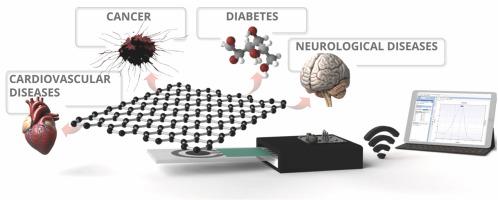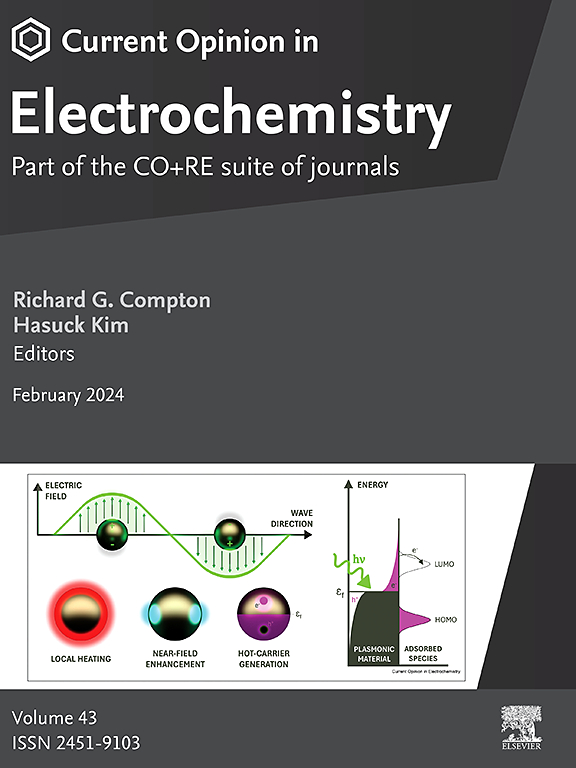Recent advances in graphene-based electrochemical biosensors for major non-communicable diseases
IF 6.9
2区 化学
Q1 CHEMISTRY, PHYSICAL
引用次数: 0
Abstract
Non-communicable diseases, including cancer, cardiovascular diseases, diabetes, and neurological disorders, represent a growing global health challenge, driving an urgent need for rapid, sensitive, and affordable diagnostic technologies. Graphene-based materials, with their exceptional physicochemical properties, offer transformative potential for the development of next-generation electrochemical biosensors. This review highlights recent advancements in the use of graphene derivatives (such as reduced graphene oxide, graphene quantum dots, laser-induced graphene, and covalently functionalized graphene) for the electrochemical detection of key biomarkers associated with major non-communicable diseases. We critically analyze strategies for enhancing biosensor performance, discuss innovations in biomarker recognition and real-sample validation, and underscore emerging trends toward wearable, minimally invasive platforms. Particular emphasis is placed on the challenges of selectivity, stability, and clinical translation, as well as on the need for reproducible material synthesis and device standardization. By bridging material science with biomedical applications, graphene-based biosensors are poised to enable earlier diagnosis, continuous monitoring, and improved management of non-communicable diseases, ultimately contributing to the advancement of global healthcare.

用于重大非传染性疾病的石墨烯电化学生物传感器的最新进展
非传染性疾病,包括癌症、心血管疾病、糖尿病和神经系统疾病,是日益严重的全球卫生挑战,迫切需要快速、敏感和负担得起的诊断技术。石墨烯基材料以其独特的物理化学特性,为下一代电化学生物传感器的发展提供了革命性的潜力。本文综述了石墨烯衍生物(如还原氧化石墨烯、石墨烯量子点、激光诱导石墨烯和共价功能化石墨烯)在电化学检测与主要非传染性疾病相关的关键生物标志物方面的最新进展。我们批判性地分析了提高生物传感器性能的策略,讨论了生物标志物识别和真实样本验证的创新,并强调了可穿戴、微创平台的新兴趋势。特别强调的是选择性,稳定性和临床翻译的挑战,以及对可重复性材料合成和设备标准化的需求。通过将材料科学与生物医学应用相结合,石墨烯生物传感器有望实现非传染性疾病的早期诊断、持续监测和改进管理,最终为促进全球医疗保健作出贡献。
本文章由计算机程序翻译,如有差异,请以英文原文为准。
求助全文
约1分钟内获得全文
求助全文
来源期刊

Current Opinion in Electrochemistry
Chemistry-Analytical Chemistry
CiteScore
14.00
自引率
5.90%
发文量
272
审稿时长
73 days
期刊介绍:
The development of the Current Opinion journals stemmed from the acknowledgment of the growing challenge for specialists to stay abreast of the expanding volume of information within their field. In Current Opinion in Electrochemistry, they help the reader by providing in a systematic manner:
1.The views of experts on current advances in electrochemistry in a clear and readable form.
2.Evaluations of the most interesting papers, annotated by experts, from the great wealth of original publications.
In the realm of electrochemistry, the subject is divided into 12 themed sections, with each section undergoing an annual review cycle:
• Bioelectrochemistry • Electrocatalysis • Electrochemical Materials and Engineering • Energy Storage: Batteries and Supercapacitors • Energy Transformation • Environmental Electrochemistry • Fundamental & Theoretical Electrochemistry • Innovative Methods in Electrochemistry • Organic & Molecular Electrochemistry • Physical & Nano-Electrochemistry • Sensors & Bio-sensors •
 求助内容:
求助内容: 应助结果提醒方式:
应助结果提醒方式:


